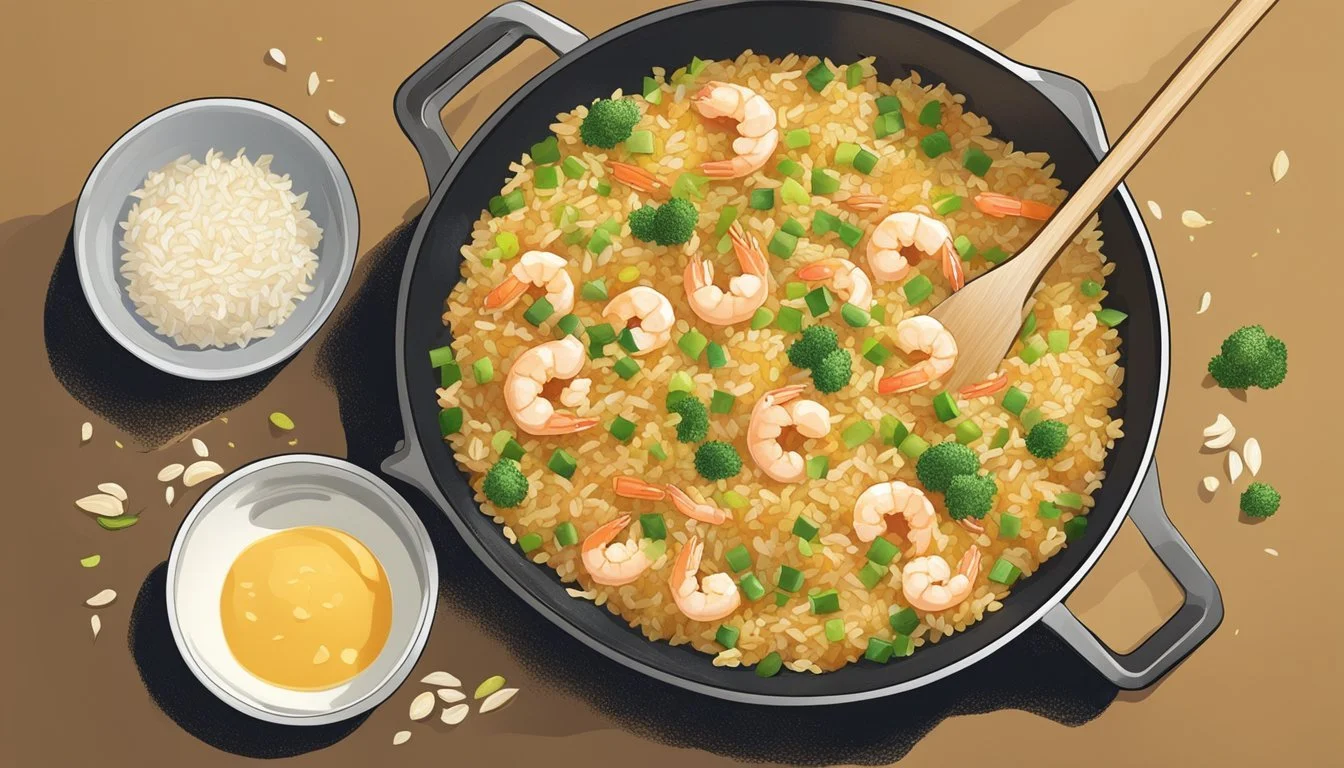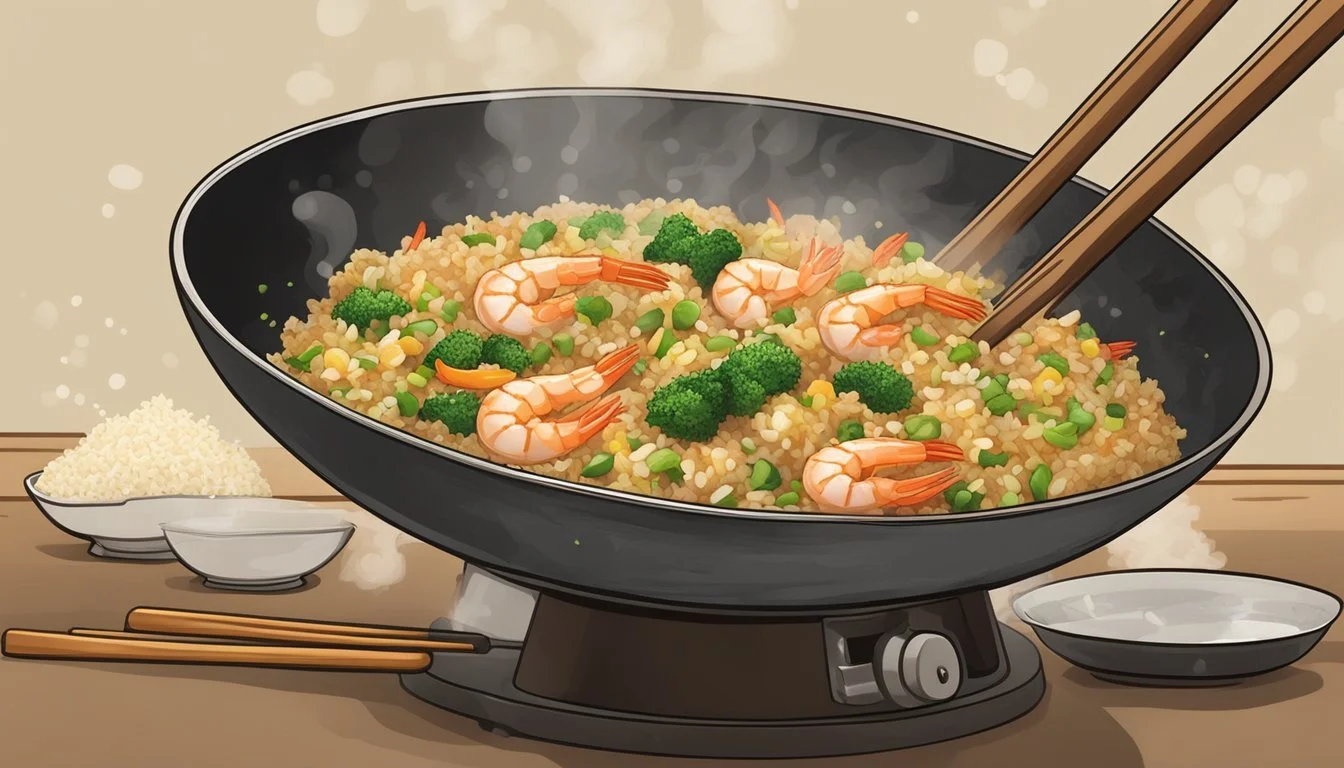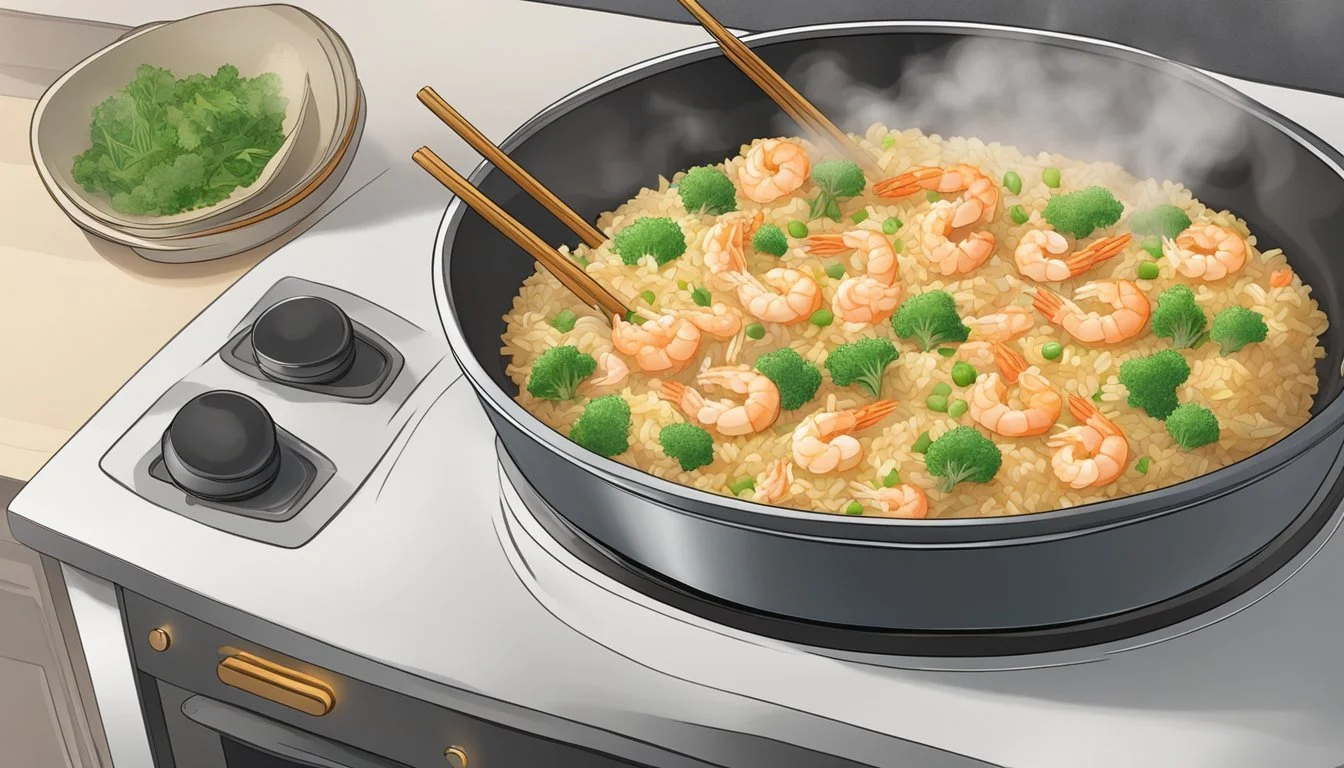Best Way to Reheat Shrimp Fried Rice
Tips for Maintaining Crispiness and Aroma
Reheating shrimp fried rice (What wine goes well with rice?) so it retains its crispiness and aromatic appeal requires precision and a few key techniques. Whether serving for a quick lunch or as an accompaniment for dinner, the challenge often lies in restoring the dish's texture and flavor, which can diminish after refrigeration. Addressing this issue head-on allows diners to enjoy leftover shrimp fried rice that is almost as fresh as when it was first made.
The method of reheating has a significant impact on the outcome. Using a microwave might seem convenient, but it can lead to soggy rice and rubbery shrimp if not done correctly. On the contrary, stove-top reheating allows for greater control over heat distribution, which is crucial in reviving the dish's original crispiness and aroma. Additionally, adding small amounts of liquid can prevent dryness, while constant stirring can assist in evenly heating the rice and shrimp.
Attention to detail transforms the simple act of reheating into an opportunity to rejuvenate leftover shrimp fried rice to its former glory. By choosing the right technique and considering factors such as heat level and moisture content, the dish can be enjoyed a second time, offering a satisfying texture and robust flavor that closely mimics its initial serving.
Understanding Rice Reheating Fundamentals
When reheating shrimp fried rice, one must consider the importance of safe storage, the risks of food poisoning, and how to maintain the desired crispness and aromatic qualities.
Importance of Proper Storage
Proper storage is essential to maintain the quality of leftover fried rice. Leftovers should be cooled quickly and placed in an airtight container to preserve moisture and flavor. The container then needs to be stored in the refrigerator at temperatures below 40°F (4°C) to slow down the growth of bacteria and maintain freshness for reheating.
Avoiding Food Poisoning
To avoid food poisoning, it's imperative to handle leftover fried rice correctly. Bacillus cereus is a common bacterium found in rice that can cause foodborne illness. To minimize the risk, one should:
Refrigerate leftovers within two hours of cooking.
Ensure that the refrigerator’s temperature is set to or below 40°F (4°C).
These precautions prevent the bacteria from multiplying to dangerous levels.
Preserving the Right Texture
The key to preserving the texture of shrimp fried rice lies in managing moisture levels during reheating:
For a moist texture, add a small amount of water before reheating.
For a crispy texture, ensure any added liquid is minimal and the reheating method allows moisture to escape—such as using a pan on the stove.
Reheating shrimp fried rice requires a balanced approach that prioritizes safety, maintains moisture without sogginess, and preserves the dish's overall texture and flavor.
Preparing Fried Rice for Reheating
Proper preparation of fried rice before reheating is crucial to maintaining its flavor and texture. Optimizing the condition of the rice ensures the reheating process will return it to its original savory and crispy state.
Bringing to Room Temperature
Before reheating shrimp fried rice, it's best to let leftover rice sit out until it reaches room temperature. This step is vital because it allows for even reheating and helps prevent the rice from becoming too tough or dry when heat is applied. A uniform temperature throughout the rice means it will heat evenly, preventing some parts from overheating while others remain cold.
Take the fried rice out of the refrigerator at least 30 minutes before reheating.
Spread the rice on a plate or a flat surface to quicken the process.
Portioning for Even Reheating
Dividing the rice into smaller portions can significantly aid in achieving uniformly heated fried rice.
Portion the fried rice into smaller, manageable amounts rather than reheating a large block of refrigerated rice.
Single-serving sizes ensure that heat penetrates the rice more efficiently.
By following these preparatory steps, fried rice can be reheated to be as aromatic and crispy as when it was first served.
Stovetop Reheating Technique
Using the stovetop method to reheat shrimp fried rice can achieve a delightful balance of crispiness and flavor retention. Careful control of oil and temperature is essential for this approach.
Using Oil and Stir-Frying
Tools Needed:
Pan: A non-stick or well-seasoned cast iron pan is ideal.
Spatula: For continuous stirring.
Procedure:
Add Oil: Drizzle a small amount of cooking oil into the pan—just enough to lightly coat the bottom. The pan should be set over medium heat.
Add Fried Rice: Once the oil is hot, incorporate the shrimp fried rice, spreading it evenly.
Stir-Frying: Continuously stir the fried rice to ensure even exposure to the heat. This technique helps to maintain the shrimp's texture and the rice's crispness without absorbing excess oil.
Heat Distribution and Avoiding Overcooking
Temperature Control:
Medium Heat: It's crucial to keep the stove set to a medium heat setting. Too high, and the rice and shrimp may burn; too low, and they won't reheat properly.
Stirring:
Constant: Stir regularly to promote uniform heating.
Gentle: A light touch prevents the rice from becoming mushy and helps to avoid overcooking the shrimp.
Time Management:
Quick: The reheating should be swift, usually taking no more than a few minutes.
Attentive: One must remain attentive to the changes in the rice and shrimp to prevent overcooking.
By employing these techniques on the stovetop, reheating shrimp fried rice can be done effectively, preserving the meal's inherent flavors and textures.
Oven Reheating Process
Reheating shrimp fried rice in the oven can maintain its texture and aroma if done correctly. This section provides a step-by-step approach to ensure that crispiness is preserved and moisture is retained.
Preheating and Baking Sheet Preparation
Firstly, one should preheat the oven to 300°F (150°C). While the oven is warming up, they should take a baking sheet and lightly cover it with aluminum foil. This helps in easy cleanup later and assists in maintaining the fried rice's texture by preventing sticking. If a wire rack is available, it's advisable to place it on the baking sheet to allow heat circulation, which can contribute to a more even reheating.
Covering with Foil to Retain Moisture
Once the shrimp fried rice is spread out in a single layer on the baking sheet, it should be sprinkled with a few tablespoons of water. This step is crucial as it helps to retain moisture in the rice. After adding the water, one must cover the entire sheet snugly with tin foil. The foil acts as a lid, trapping steam and keeping the rice from drying out. The shrimp fried rice should then be placed in the preheated oven for 10 to 15 minutes, ensuring that it is heated thoroughly without overcooking.
Microwave Reheating Strategy
When reheating shrimp fried rice in the microwave, one must carefully select the power setting and utilize steam for optimal freshness and texture.
Selecting the Right Power Setting
To maintain the quality of shrimp fried rice, reheating it using a lower power setting on the microwave is crucial. This slower reheating process helps to preserve the texture of the rice and prevents overheating the shrimp.
Recommended Procedure:
Place the rice in a microwave-safe container.
Cover the container loosely with a microwave-safe lid or use plastic wrap with small holes poked in it to allow steam to escape.
Set the microwave to medium (50% power) level.
Reheat in short intervals of 30 seconds, stirring in between, until the rice is evenly heated through. This could take a total of 1-2 minutes depending on the amount of rice.
Using Steam to Refresh Rice
Steam plays an essential role in restoring the moisture lost from the rice during refrigeration. Adding a little liquid and covering the dish helps to generate steam.
Steps for Steaming:
Before placing the rice in the microwave, sprinkle a small amount of water over the rice. One can also use a damp paper towel to cover the rice, which will contribute moisture and assist with even reheating.
The steam generated will refresh the rice, making it more aromatic and restoring a desirable texture.
Remember to stir the rice at least once during the reheating process to distribute the heat and steam throughout the rice for even warming.
Alternative Reheating Methods
To achieve the delicate balance of crispiness and aromatic flavors in shrimp fried rice, one can explore reheating methods that differ from the conventional microwave or oven heating. The use of an air fryer or employing steam-frying on the stovetop can provide satisfying results that preserve the dish's texture and taste.
Utilizing the Air Fryer for Crispiness
An air fryer is an excellent tool for reheating shrimp fried rice while retaining its crispiness. The rapid air circulation it provides ensures that each grain of rice gets evenly heated and maintains a desirable texture. To do this:
Preheat the air fryer to 350°F (175°C).
Spread the fried rice evenly in the fryer basket to allow for proper air flow. Avoid overcrowding.
Reheat the rice for 3-5 minutes. This short duration is crucial to prevent the rice from drying out.
Stir halfway through the reheating process to ensure even exposure to the air fryer's heat.
It's important to note that not all air fryers operate identically, so users may need to adjust the timing slightly depending on their model.
Steam-Frying on the Stovetop
Steam-frying provides a method to refresh the rice's moisture and aroma while rejuvenating the shrimp's tenderness. This involves:
Adding a small amount of oil or butter to a skillet or pan and placing it over medium heat.
Once the pan is hot, add the fried rice and distribute it evenly.
Pour in a few tablespoons of water or broth to generate steam.
Cover with a lid to trap the steam and let the rice heat for a few minutes.
Stir-fry occasionally to prevent sticking and promote even reheating.
By following these steps and carefully controlling the heat, one can reheat shrimp fried rice on the stovetop effectively, enhancing its overall flavor and texture through steam-frying.
Enhancing Flavor and Aroma After Reheating
Reheating shrimp fried rice can lead to a loss in its characteristic flavor and crispiness. However, by adding fresh ingredients and using spices and condiments correctly, one can rejuvenate the dish to its near-original splendor.
Adding Fresh Ingredients
Incorporating fresh vegetables and green onions into shrimp fried rice after reheating does wonders for both texture and aroma. A simple method is:
Quickly sauté vegetables like peas or diced carrots in a small amount of oil or butter until just tender.
Fold these into the reheated rice to preserve their crunch.
Adding a handful of chopped green onions before serving reintroduces a fresh, pungent kick which complements the rice and shrimp beautifully.
Correct Use of Spices and Condiments
Spices and condiments are pivotal in restoring the lost aromas during reheating. They must be used with precision:
A drizzle of sesame oil can impart a nutty scent and rich flavor that penetrates the rice.
A splash of soy sauce not only seasons the rice but also moistens it, reviving the dish's savory notes without overwhelming the other flavors.
When using spices and condiments, one must do so sparingly to avoid overpowering the delicate seafood taste of the shrimp.
Safety Considerations
When reheating shrimp fried rice, it's crucial to reach the appropriate internal temperature to ensure food safety and to avoid cross-contamination.
Ensuring Safe Internal Temperature
To ensure shrimp fried rice is safe to reheat and consume, one must verify that it has reached an internal temperature of 165°F. This can be checked using a food thermometer, which should be inserted into the thickest part of the rice and shrimp mixture. Doing so not only complies with food safety guidelines but also helps in maintaining the dish's quality.
Safe Reheating Temperatures: 165°F (internal temperature)
Preventing Cross-Contamination
During the reheating process, it's crucial to prevent cross-contamination:
Utensils: Always use clean utensils when handling reheated shrimp fried rice.
Surface Cleaning: Before and after reheating, clean all surfaces involved in the process with a suitable kitchen cleaner or hot soapy water.
Storage: Keep the shrimp fried rice separate from raw foods and use airtight containers to prevent bacterial transfer.
Common Pitfalls and How to Avoid Them
Reheating shrimp fried rice presents unique challenges, particularly in retaining the dish's crispness and rich aroma. Understanding and addressing common issues such as sogginess and dryness, as well as properly reheating proteins and veggies, are key to enjoying leftover shrimp fried rice that is as satisfying as when it was first served.
Dealing with Sogginess and Dryness
Sogginess can ruin the texture of fried rice, turning what should be a delightful dish into a mushy disappointment. To combat this, one should:
Reheat in stages: Start with a medium-high heat to warm the rice, then increase the heat briefly at the end to restore crispness.
Utilize a non-stick skillet: Heat the rice without oil initially to allow any excess moisture to evaporate.
Dryness is the opposite problem, where the rice becomes too hard. To avoid this:
Add moisture carefully: A small splash of water, broth, or soy sauce can be introduced to the skillet while reheating. Cover with a lid to trap steam and rehydrate the grains.
Managing Leftover Proteins and Veggies
Leftover Proteins: Reheating chicken and shrimp requires gentle heat to avoid overcooking.
Reheat separately: If possible, warm proteins like leftover chicken or shrimp in a separate pan before combining with the rice.
Watch the time: Proteins should be heated just until they're warmed through to prevent them from becoming tough.
Veggies: The key to maintaining the texture and color of leftover veggies is brief reheating.
Short reheat time: Veggies should be added at the last moment, as they need less time to warm up.
Maintain crispness: Stir them into the rice just long enough to get heated without losing their bite.




